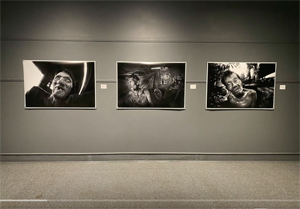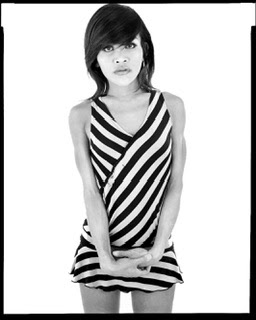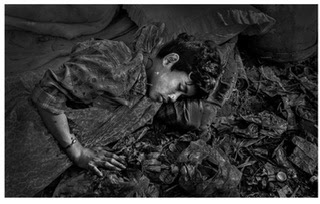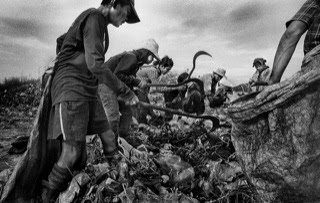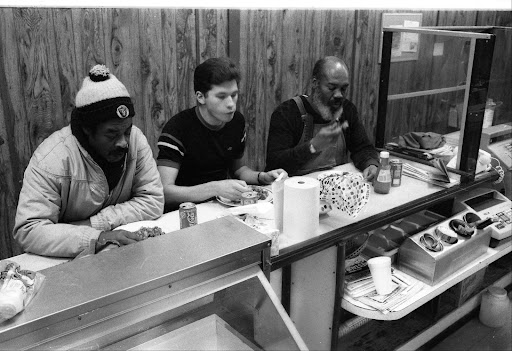
--------------------------------------------------------------------------------
January 27, 2008
Art
The Capa Cache
By RANDY KENNEDY
TO the small group of photography experts aware of its existence, it was known simply as “the Mexican suitcase.” And in the pantheon of lost modern cultural treasures, it was surrounded by the same mythical aura as Hemingway’s early manuscripts, which vanished from a train station in 1922.
The suitcase — actually three flimsy cardboard valises — contained thousands of negatives of pictures that Robert Capa, one of the pioneers of modern war photography, took during the Spanish Civil War before he fled Europe for America in 1939, leaving behind the contents of his Paris darkroom.
Capa assumed that the work had been lost during the Nazi invasion, and he died in 1954 on assignment in Vietnam still thinking so. But in 1995 word began to spread that the negatives had somehow survived, after taking a journey worthy of a John le Carré novel: Paris to Marseille and then, in the hands of a Mexican general and diplomat who had served under Pancho Villa, to Mexico City.
And that is where they remained hidden for more than half a century until last month, when they made what will most likely be their final trip, to the International Center of Photography in Midtown Manhattan, founded by Robert Capa’s brother, Cornell. After years of quiet, fitful negotiations over what should be their proper home, legal title to the negatives was recently transferred to the Capa estate by descendants of the general, including a Mexican filmmaker who first saw them in the 1990s and soon realized the historical importance of what his family had.
“This really is the holy grail of Capa work,” said Brian Wallis, the center’s chief curator, who added that besides the Capa negatives, the cracked, dust-covered boxes had also been found to contain Spanish Civil War images by Gerda Taro, Robert Capa’s partner professionally and at one time personally, and by David Seymour, known as Chim, who went on to found the influential Magnum photo agency with Capa.
The discovery has sent shock waves through the photography world, not least because it is hoped that the negatives could settle once and for all a question that has dogged Capa’s legacy: whether what may be his most famous picture — and one of the most famous war photographs of all time — was staged. Known as “The Falling Soldier,” it shows a Spanish Republican militiaman reeling backward at what appears to be the instant a bullet strikes his chest or head on a hillside near Córdoba in 1936. When the picture was first published in the French magazine Vu, it created a sensation and helped crystallize support for the Republican cause.
Though the Capa biographer Richard Whelan made a persuasive case that the photograph was not faked, doubts have persisted. In part this is because Capa and Taro made no pretense of journalistic detachment during the war — they were Communist partisans of the loyalist cause — and were known to photograph staged maneuvers, a common practice at the time. A negative of the shot has never been found (it has long been reproduced from a vintage print), and the discovery of one, especially in the original sequence showing all the images taken before and after the shot, could end the debate.
But the discovery is being hailed as a huge event for more than forensic reasons. This is the formative work of a photographer who, in a century defined by warfare, played a pivotal role in defining how war was seen, bringing its horrors nearer than ever — “If your pictures aren’t good enough, you’re not close enough” was his mantra — yet in the process rendering it more cinematic and unreal. (Capa, not surprisingly, later served a stint in Hollywood, befriending directors like Howard Hawks and romancing Ingrid Bergman.)
Capa practically invented the image of the globe-trotting war photographer, with a cigarette appended to the corner of his mouth and cameras slung over his fatigues. His fearlessness awed even his soldier subjects, and between battles he hung out with Hemingway and Steinbeck and usually drank too much, seeming to pull everything off with panache. William Saroyan wrote that he thought of Capa as “a poker player whose sideline was picture-taking.”
In a Warholian way that seems only to increase his contemporary allure, he also more or less invented himself. Born Endre Friedmann in Hungary, he and Taro, whom he met in Paris, cooked up the persona of Robert Capa — they billed him as “a famous American photographer” — to help them get assignments. He then proceeded to embody the fiction and make it true. (Taro, a German whose real name was Gerta Pohorylle, died in Spain in 1937 in a tank accident while taking pictures.)
Curators at the International Center of Photography, who have begun a months-long effort to conserve and catalog the newly discovered work, say the full story of how the negatives, some 3,500 of them, made their way to Mexico may never be known.
In 1995 Jerald R. Green, a professor at Queens College, part of the City University of New York, received a letter from a Mexico City filmmaker who had just seen an exhibition of Spanish Civil War photographs sponsored in part by the college. He wrote that he had recently come into possession of an archive of nitrate negatives that had been his aunt’s, inherited from her father, Gen. Francisco Aguilar Gonzalez, who died in 1967. The general had been stationed as a diplomat in the late 1930s in Marseille, where the Mexican government, a supporter of the Republican cause, had begun helping antifascist refugees from Spain immigrate to Mexico.
From what experts have been able to piece together from archives and the research of Mr. Whelan, the biographer (who died last year), Capa apparently asked his darkroom manager, a Hungarian friend and photographer named Imre Weisz, known as Cziki, to save his negatives in 1939 or 1940, when Capa was in New York and feared his work would be destroyed.
Mr. Weisz is believed to have taken the valises to Marseille, but was arrested and sent to an internment camp in Algiers. At some point the negatives ended up with General Aguilar Gonzalez, who carried them to Mexico, where he died in 1967. It is unclear whether the general knew who had taken the pictures or what they showed; but if he did, he appears never to have tried to contact Capa or Mr. Weisz, who coincidentally ended up living the rest of his life in Mexico City, where he married the Surrealist painter Leonora Carrington. (Mr. Weisz died recently, in his 90s; Mr. Whelan interviewed him for his 1985 biography of Capa but did not elicit any information about the lost negatives.)
“It does seem strange in retrospect that there weren’t more efforts to locate these things,” Mr. Wallis said. “But I think they just gave them up. They were lost in the war, like so many things.”
When the photography center learned that the work might exist, it contacted the Mexican filmmaker and requested their return. But letters and phone conversations ended with no commitments, said Phillip S. Block, the center’s deputy director for programs, who added that he and others were not even sure at the beginning if the filmmaker’s claims were true, because no one had been shown the negatives. (Saying that the return of the negatives was a collective decision of the Aguilar Gonzalez family, the filmmaker asked not to be identified in this article and declined to be interviewed for it.)
Meetings with the man were scheduled, but he would fail to appear. “And then communications broke off completely for who knows what reason,” Mr. Block said. Efforts were made from time to time, unsuccessfully, to re-establish contact. But when the center began to organize new shows of Capa and Taro’s war photography, which opened last September, it decided to try again, hoping that images from the early negatives could be incorporated into the shows.
“He was never seeking money,” Mr. Wallis said of the filmmaker. “He just seemed to really want to make sure that these went to the right place.”
Frustrated, the center enlisted the help of a curator and scholar, Trisha Ziff, who has lived in Mexico City for many years. After working for weeks simply to track down the reclusive man, she began what turned out to be almost a year of discussions about the negatives.
“It wasn’t that he couldn’t let go of this,” said Ms. Ziff, interviewed by phone from Los Angeles, where she is completing a documentary about the widely reproduced image of Che Guevara based on a photograph by Alberto Korda.
“I think it was that no one before me had thought this through in the way that something this sensitive needs to be thought through,” she said. The filmmaker worried in part that people in Mexico might be critical of the negatives’ departure to the United States, regarding the images as part of their country’s deep historical connection to the Spanish Civil War. “One had to respect and honor the dilemma he was in,” she said.
In the end Ms. Ziff persuaded him to relinquish the work — “I suppose one could describe me as tenacious,” she said — while also securing a promise from the photography center to allow the filmmaker to use Capa images for a documentary he would like to make about the survival of the negatives, their journey to Mexico and his family’s role in saving them.
“I see him quite regularly,” Ms. Ziff said, “and I think he feels at peace about this now.”
In December, after two earlier good-faith deliveries of small numbers of negatives, the filmmaker finally handed Ms. Ziff the bulk of the work, and she carried it on a flight to New York herself.
“I wasn’t going to put it in a FedEx box,” she said.
“When I got these boxes it almost felt like they were vibrating in my hands,” she added. “That was the most amazing part for me.”
Mr. Wallis said that while conservation experts from the George Eastman House in Rochester are only now beginning to assess the condition of the film, it appears to be remarkably good for 70-year-old nitrate stock stored in what essentially looks like confectionery boxes.
“They seem like they were made yesterday,” he said. “They’re not brittle at all. They’re very fresh. We’ve sort of gingerly peeked at some of them just to get a sense of what’s on each roll.”
And discoveries have already been made from the boxes — one red, one green and one beige — whose contents appear to have been carefully labeled in hand-drawn grids made by Mr. Weisz or another studio assistant. Researchers have come across pictures of Hemingway and of Federico García Lorca.
The negative for one of Chim’s most famous Spanish Civil War photographs, showing a woman cradling a baby at her breast as she gazes up toward the speaker at a mass outdoor meeting in 1936, has also been found. “We were astonished to see it,” Mr. Wallis said. (The photograph, often seen as showing the woman worriedly scanning the skies for bombers, was mentioned by Susan Sontag in “Regarding the Pain of Others,” her 2003 reconsideration of ideas from her well-known treatise “On Photography,” a critical examination of images of war and suffering.)
The research could bring about a reassessment of the obscure career of Taro, one of the first female war photographers, and could lead to the determination that some pictures attributed to Capa are actually by her. The two worked closely together and labeled some of their early work with joint credit lines, sometimes making it difficult to establish authorship conclusively, Mr. Wallis said. He added that there was even a remote possibility that “The Falling Soldier” could be by Taro and not Capa.
“That’s another theory that’s been floated,” he said. “We just don’t know. To me that’s what’s so exciting about this material. There are so many questions and so many questions not even yet posed that they may answer.”
Ultimately, Mr. Wallis said, the discovery is momentous because it is the raw material from the birth of modern war photography itself.
“Capa established a mode and the method of depicting war in these photographs, of the photographer not being an observer but being in the battle, and that became the standard that audiences and editors from then on demanded,” he said. “Anything else, and it looked like you were just sitting on the sidelines. And that visual revolution he embodied took place right here, in these early pictures.”










